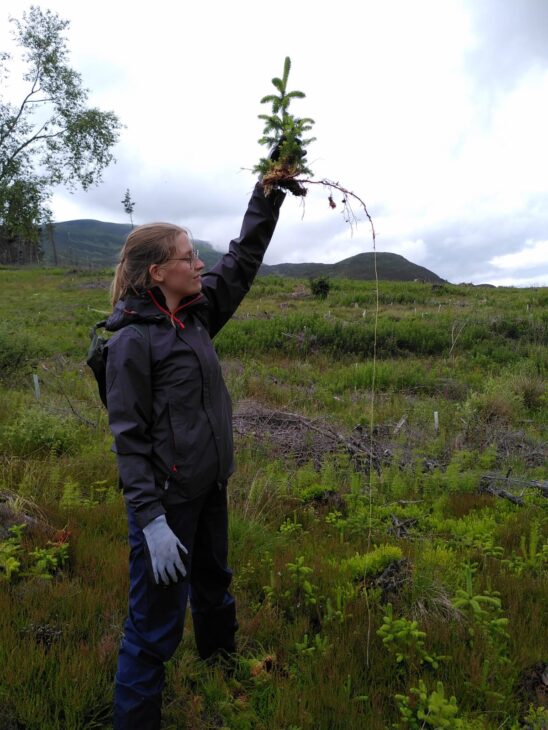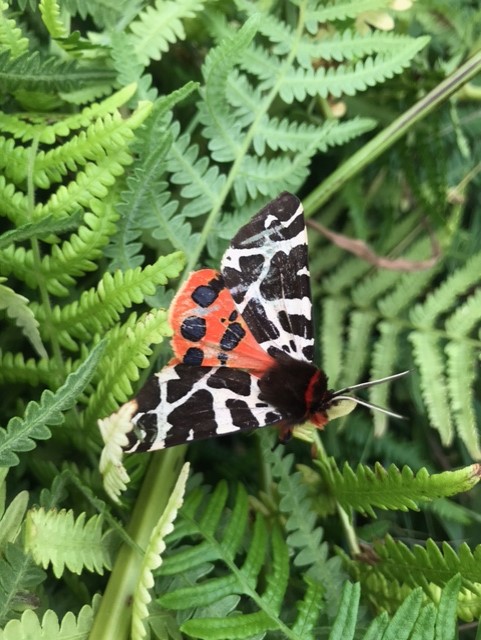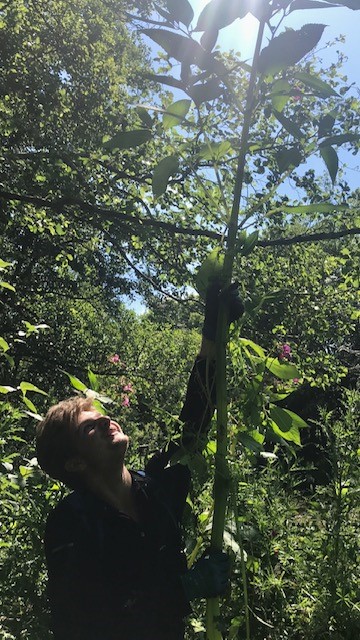Ranger round-up: bracken, balsam and a mothy bothy
It’s week three for the Seasonal Ranger team at Loch of the Lowes, but it feels more like days have passed as we’ve been kept busy working around the various Perthshire reserves, honing our plant and animal ID skills as we go. There’s been a lot to do, but we’ve already begun getting our teeth into it.
Being an early-flowering invasive, controlling the spread of lupin at the Tummel Shingle Island reserves was one of our first (and sweatiest!) tasks of the season. Firstly in the pouring rain and then the baking sun, it hasn’t been easy, but with spectacular views of leaping salmon and fishing ospreys, and with the help of some lovely volunteers, we’ve dead-headed and dug up a great deal. Lupin is lovely in our gardens, but causes problems in our freshwater shingle habitats, where its extensive root system binds the loose substrate, preventing it from shifting naturally with the river’s course. This in turn out competes rarer native species which rely on the unique growing habitat that the shingle provides.

One of our longest days involved working in partnership with the John Muir Trust (part of the Heart of Scotland Forest Partnership) clearing out the cross-drains on the main path up the mighty mountain of Schiehallion. It was hard work digging out all the soil and loose rubble, but it was rewarding to know that we were doing vital work keeping the trail well maintained and safe for everyone to enjoy. It gave us a real appreciation for all the effort involved in keeping these amazing locations accessible. We don’t think any of us will look at a trail path the same way again! To finish, we climbed up to the summit to get the best view of all our hard work before heading back down to enjoy some well-deserved fish and chips.

Aside from the lupin, another pesky plant we have been dealing with is bracken. It spreads via rhizomes (a special root system that is exceptionally tricky to remove), and will smother large swathes of land if left unmanaged, shading out other native vegetation and preventing them from growing. We have been working our way up the bracken bashing ranks. Beginning with scythes and grass hooks, we are now wrangling big patches at the Trust’s Keltneyburn Meadow, and have recently been promoted to licensed brush-cutters after a two-day course. We are moving up in the world!
As a personal project, the team have been delving into the maddening world of moth ID. Our efforts to figure out which of the 2,500 UK moth species we have here at Lowes has lead to many late nights and early mornings scrambling to photograph as many of our caught moths as we can, before they decide to take up residence in our bothy! The stunning hawkmoths and flashy large yellow underwings have become our personal favourites. We have identified over forty species so far but we still have plenty more to discover.

With lupin pulling firmly under our belts, we have recently begun tackling Himalayan balsam on our Tummel Shingle Island reserves. Another non native introduced to ornamental garden by the Victorians, this plant is a particular problem along waterways, as a single plant’s explosive seedpods can fling up to 800 seeds, which then can be spread far and wide downstream. Thanks to the endeavours of previous seasonal rangers, the balsam problem is much reduced and our job has been made a lot easier. If only there weren’t so many brambles thickets to wrestle with on the way!

It looks like we’ll be in for another busy few weeks so stay tuned for more Ranger Round-Ups as the season continues.
The Assistant Ranger Team
Help protect Scotland’s wildlife
Our work to save Scotland’s wildlife is made possible thanks to the generosity of our members and supporters.
Join today from just £4 a month to help protect the species you love.
Preface
It’s week three for the Seasonal Ranger team at Loch of the Lowes, but it feels more like days have passed as we’ve been kept busy working around the various …
